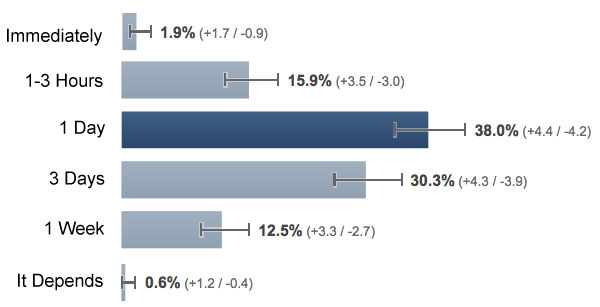Updated May 8th, 2023
Mike Blumenthal took a deep look at customer complaints with a series of articles. View all of the posts covering strategy, ideas, customer insight, survey data, and more to improve how your business handles customer complaints.
So, how quickly should a business respond to a complaint? Let’s get one thing straight, in a perfect world, it’s as soon as as possible.
Customers want to feel heard and understood. If a customer complaint is left unattended, they are likely to feel ignored and undervalued, leading to a loss of trust and a negative view of the company. Responding quickly shows that you take their concerns seriously and value their feedback, which can help retain their business.
By responding promptly and effectively, you can turn a negative experience into a positive one. Customers who have had their concerns addressed quickly are more likely to feel satisfied with the outcome and may even become loyal customers.
When customers see that you take their complaints seriously and resolve them quickly, they are more likely to become loyal to your brand. This can lead to positive reviews and word-of-mouth referrals, which can ultimately increase your customer base and revenue.
So here’s just how quickly you need to respond to customer complaints.
How Quickly to Respond to a Customer Compliant
According to a study by HubSpot, 90% of customers rate an “immediate” response as important or very important when they have a customer service question. But consumers may offer you more leeway than you had previously thought in terms of when they expect you to resolve the issue. Most small businesses attempt to deal with complaints in real time but as your business grows and as the communication channels into your business fragment (phone, text, social media, email) that becomes harder.
But what is the optimal time from a consumer’s point of view? We decided to ask a more representative group of consumers what their expectations were. The question we asked of a sample (n=480) of US adults was simple:
When you complain to a local merchant how long is reasonable for them to respond & resolve?
The answers were somewhat more lenient than expected. The fact that almost 1/3 of respondents indicated that 3 days were soon enough and another 12.5% were satisfied with a week was surprising. But in general, you see the majority (53%) feel it’s pertinent to respond within 1 day (if not sooner).
When dealing with national organizations who generally don’t prioritize complaint resolution it can take anywhere from 3 to 7 days for a first response. But for most businesses that really isn’t ideal.
As a consumer, the more distraught and troublesome the problem, the sooner you expect a response to begin to resolve the problem. So the 3 to 7-day window likely isn’t going to cut it.
How to Handle the Customer Complaint
The means by which the customer communicated their complaint will be the biggest factor in consumer expectations for the speed. When in person or on a call the customer is likely to expect immediate answers while email is likely to have an expectation of somewhat more delay and possible back and forth.
We also surveyed consumers to understand their preferred method of communicating a complaint and they would rather do it face-to-face. But in-person and on the phone both run the risk of the business letting emotions control the conversation rather than your “better person” and reason.
Sometimes it is hard to put yourself “in the right headspace” when you are face to face with a distraught human being and you are feeling attacked. In this case, a delayed resolution tactic may be more beneficial. As Nicholas McDonough of Verbatim Marketing Agency pointed out in some excellent advice: If the customer remains angry, capture their info and call them back. Give them a short time frame. Trying to resolve a problem with an angry person will be far too difficult.
This will give the customer some time to cool down and give you the time to think through your response and answer in a voice that best represents the business. You can more easily understand the situation, think through the appropriate resolution, and manage the interaction.
Complaint Response Timing, Process & Advice
The final decision on your response is very much dependent on the details and complexity of the problem and the nature of your business.
Here are three simple rules to help serve your complaint response process:
1- Start and Control The Process
Start and control the complaint process rather than leave it to chance. Survey every customer and invite their feedback. When you start the process by asking for feedback and you solicit a complaint you will have more control of the tone, the timing, and the forum for resolving the complaint. The customer will appreciate that you initiated the conversation and will give you the benefit of the doubt as to the timeframe for solving it.
2- Set a Complaint Response and Resolution Time Goal
Our survey shows many consumers have a window of days for you to respond, but the sooner the better for your business and your customer. Set a standard for your business and team to have both an initial response time and then a resolution time.
Our survey data suggests that if you respond within the hour and resolve the majority of complaints within the day, you will be on the right side of your consumers.
3- Make Complaints Easy
While this ties in with the first point, it’s also important to offer an easy way for customers to share their opinion or frustrations through the channels they prefer. Making your customers aware you want and take feedback via email, text, your website, phone, and in person is critical to making them feel comfortable doing so with ease.


Comments are closed.